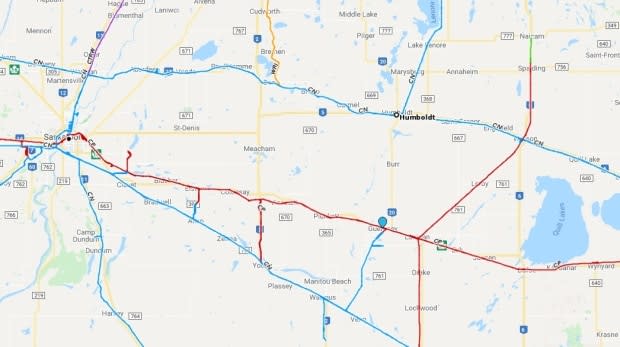Experts weigh in on latest safety measures following 2 Sask. oil train crashes

Industry experts are reacting to the latest moves by Transport Canada and the Transportation Safety Board of Canada to reduce the risk of train crashes, following two recent oil train derailments near the same rural Saskatchewan community.
Two CP Rail trains carrying oil from ConocoPhillips jumped the tracks on CP's Sutherland subdivision within two months of each other. The latest fiery crash happened on Feb. 6, just west of the small hamlet of Guernsey. The first, on Dec. 9, 2019, happened east of the community.
Soon after the second derailment, federal Transport Minister Marc Garneau ordered all large trains carrying dangerous goods to slow down their speeds, citing concern about crashes over the previous year.
The order outlined temporary new maximum speed limits for trains travelling through metropolitan and rural areas.
On Sunday, that order was revised, with Garneau retroactively relaxing some of his new speed limits but reserving the most stringent new limit (40 km/h) for high-risk trains travelling in areas without track signals. Such areas are known in the rail industry as "dark territory."
CP's Sutherland subdivision, which stretches eastward for about 180 kilometres from Saskatoon to Wynyard, is non-signalled dark territory and is supervised by a rail traffic controller located in Calgary, according to the TSB.

Ian Naish, a former director of rail investigations with the TSB, said the new dark territory speed limits stand out.
"It looks like Transport Canada is saying broken rails have been a major factor in several recent derailments of these types of train," Naish said.
"Broken rails are often detected by the signal track circuits in time to avoid a derailment. That may explain the different criteria laid out in the ministerial order."
'Permanent' measures flagged
Sunday's revised ministerial order also stated that Transport Canada is working with railway companies to develop "a more comprehensive" and "permanent" set of safety measures.
Those measures will focus on "track infrastructure maintenance [and] winter operations," among other things.
Bruce Campbell, an adjunct professor in York University's Faculty of Environmental Studies, released a book in 2018 called "The Lac-Mégantic Rail Disaster."
In it, Campbell argued that the July 2013 train derailment in Lac-Mégantic, Que., which killed 47 people, was the violent culmination of decades of self-regulation in Canada's rail industry.
Campbell said any review of rail safety therefore has to be open to non-industry groups. The results should be released publicly, he added.
"My call is for transparency," Campbell said. "Not just an internal conversation between Transport Canada and the railways. [Garneau] has to communicate it with the public at large. Otherwise that skepticism will continue."

Transport Canada has confirmed that the Sutherland subdivision track was inspected twice in 2019.
"Minor non-compliances" were found on both occasions, but Transport Canada has declined to specify what issues were found.
CP also declined to clarify what the "minor non-compliances" were, citing the TSB's ongoing investigation of the Feb. 6 crash.
In a preliminary update issued Friday, the TSB said it found no signs of mechanical problems on the Feb. 6 train that could account for the crash.
"The train was handled in accordance with regulatory and company requirements," it added.
The topic of track conditions was not broached at all in the TSB's update.
The TSB confirmed the Feb. 6 CP train — which was carrying diluted bitumen that burst into flames after the crash and continued to burn for a day and a half along Saskatchewan Highway 16 — was using newly-built TC-117 tank cars.
The TSB said there was "significant industry interest" in documenting the performance of the TC-117 cars.
Campbell said this makes sense, given Transport Canada's 2016 endorsement of the TC-117 cars as being safer than those involved in the Lac-Mégantic disaster.
"They've got the state of the art train car and….you know, these cars [are still] piling up on top of each other, puncturing," Campbell said. "They may start to think they better look at ways in which they can transport this stuff in a less volatile form."
Dan Tsubouchi, the chief market strategist for SAF Group, a Calgary-based private equity and credit investment firm with an interest in the energy industry, said TC-117s are "the top of the line tank cars."
In a note to investors Sunday, Tsubouchi wrote, "We have to believe it's not just the rail companies that are interested in the [TC-117] performance. Rather, it's all parts of the supply chain, from producers, shippers, rail companies and refineries."
Trinity Rail, the Dallas-based company that manufactured the TC-117 tanks cars involved in the Feb. 6 crash, has confirmed it is "proactively monitoring" the situation.
CP 'fully complying' with new speed limits
According to Naish, the former TSB director, Transport Canada's lower speed limits for dark territory aren't necessarily only about potentially damaged tracks.
"It also suggests that they believe tank cars are much more likely to survive derailments at [lower] speeds without a major breach," he said.
Before Garneau's slowdown order, the maximum speed limit on the Sutherland subdivision was 72 km/h.
The Dec. 9 train was travelling at about that speed, according to the TSB, while the Feb. 6 train was travelling at a slightly slower speed — about 67 kilometres an hour.
The revised order now caps the speed on the line to 40 kilometres an hour for large trains hauling dangerous goods. The Feb. 6 train was pulling a total of 104 cars, 32 of which derailed.
Garnearu's new speeds will stay in effect until April 1.
"CP is fully complying with the amended ministerial order," said Salem Woodrow, a CP spokesperson. "As a leader in rail safety, we equally share Minister Garneau's concerns and remain committed to safe operations, as we always have been."

